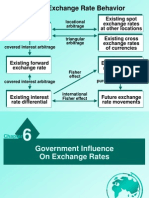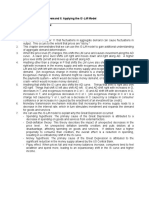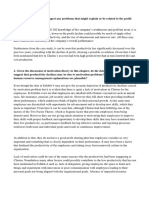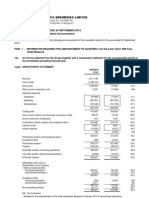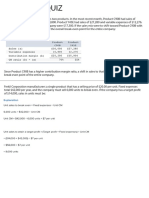International Adjustment and Interdependence
International Adjustment and Interdependence
Uploaded by
kushalCopyright:
Available Formats
International Adjustment and Interdependence
International Adjustment and Interdependence
Uploaded by
kushalOriginal Description:
Original Title
Copyright
Available Formats
Share this document
Did you find this document useful?
Is this content inappropriate?
Copyright:
Available Formats
International Adjustment and Interdependence
International Adjustment and Interdependence
Uploaded by
kushalCopyright:
Available Formats
Chapter 20
International Adjustment
and Interdependence
Introduction
Countries are interdependent
Booms or recessions in one country spill over to other countries
through trade flows
Changes in interest rates in any major country cause immediate
exchange or interest rate movements in other countries
In this chapter we explore the issues of international
interdependence further:
Mechanisms
through which a country with a fixed exchange rate
adjusts to balance of payments problems
Aspects of behavior of the current flexible exchange rate system
20-2
Adjustment Under Fixed Exchange
Rates
Adjustment to a balance-of-payments problem can be
achieved in two ways:
Change
in economic policy
Monetary policy
Fiscal policy
Tariffs
Devaluations
Automatic
adjustment mechanisms
Money supply spending
Unemployment wages and prices competitiveness
20-3
The Role of Prices in the Open
Economy
The real exchange rate is expressed as:
ePf
R
P
(1)
assume that exchange rate and foreign prices are given
How does the openness of the economy affect
the aggregate demand curve?
An
increase in the price level reduces demand
Higher price level implies lower real balances, higher interest rates,
and reduced spending
Given the exchange rate, our goods are more expensive to
foreigners and their goods are relatively cheaper for us to buy
exports decrease and imports increase
20-4
The Role of Prices in the Open
Economy
Figure 20-1 shows the
downward sloping AD curve
where AD DS NX and the
NX = 0 curve
At point E the home country
has a trade deficit (and also
unemployment)
[Insert Figure 20-1 here]
To achieve trade balance
equilibrium, we would have to
Become more competitive
(export more and import less)
Reduce income in order to
reduce import spending
20-5
The Role of Prices in the Open
Economy
What should the country do?
The central bank could use its
reserves to finance temporary
imbalances of payments
Can borrow foreign currencies
abroad
[Insert Figure 20-1 here]
May be difficult if the countrys
ability to repay the debt is in
question
Country
must find a way of
adjusting the deficit
Cannot maintain and finance
current account deficits
indefinitely
20-6
The Role of Prices in the Open
Economy
Automatic adjustment
When the central bank sells
foreign exchange, it reduces
domestic high powered money
and the money stock
[Insert Figure 20-1 here]
The central bank is selling foreign
exchange to keep the exchange
rate from depreciating
This reduces the money supply
Over time the AD schedule,
which is drawn for a given money
supply, will be shifting downward
and to the left
20-7
The Role of Prices in the Open
Economy
Automatic adjustment
There is unemployment at E
Unemployment leads to falling
wages and costs
Over time, the AS and AD both
shift
Process continues until it
reaches E
Point E is a LR equilibrium
point and there is no need for
exchange market equilibrium
automatic adjustment
[Insert Figure 20-1 here]
20-8
Policies to Restore Balance
The classical adjustment process takes time
It is also politically costly adjustment occurs because
unemployment pushes down wages and prices
Price of adjustment is recession
Alternative policies to restore external balance needed
20-9
Policies to Restore Balance
Can use policies to reduce aggregate demand
expenditure reducing policies
The trade deficit is expressed as NX Y (C I G ) (2)
A balance-of-trade deficit can be reduced by reducing spending
(C+I+G) relative to income through restrictive monetary and/or
fiscal policy
The link between the external deficit and budget deficits is
shown in equation (2a): NX ( S I ) [TA (G TR)] (2a)
If S and I are constant, changes in the budget would translate one
for one into changes in the external balance
Budget cutting would bring about equal changes in the external
deficit but budget cutting will affect S and I, thus need a more
complete model to explain how budget cuts affect external balance
20-10
Devaluation
The unemployment that accompanies automatic
adjustment suggests the need for an alternative policy for
restoring internal and external balance
The major policy instrument for dealing with payment
deficits is devaluation = an increase in the domestic
currency price of foreign exchange
Given the nominal prices in the two countries, devaluation:
Increases the relative price of imported goods in the devaluing
country
Reduces the relative price of exports from the devaluing country
Devaluation is primarily an expenditure switching policy.
20-11
Devaluation
Devaluation moves the NX=0 curve up and to the right
This helps reduce the current-account deficit
Lower prices of home-country exports AD shifts up
and to the right
Devaluation also lowers unemployment
Note: inability to devalue is one of the main costs of
giving up independent currency and participating in a
currency union
Competitiveness must be restored by falling prices/wages which
more painful and protracted
20-12
Exchange Rates and Prices
The price level typically changes with the exchange rate
after a devaluation (esp. for small open economies)
The essential issue when a country devalues is whether it
can achieve a real devaluation
A real
devaluation occurs when it reduces the price of the
countrys own goods relative to the price of foreign goods
The definition of the real exchange rate:
ePf
R
P
A real
devaluation occurs when e/P rises or when the exchange
rate increases by more than the price level
20-13
Exchange Rates and Prices
In countries that have moderate inflation, the benefits of
devaluation are only temporary
Solution: crawling peg rather than firm peg
The exchange rate is depreciated at a rate approximately
equivalent to the inflation rate
Caveat: this undermines the role the exchange rate plays
as an external anchor for inflation stabilization
20-14
The Monetary Approach
to the Balance of Payments
BP imbalance affects money supply
Country with BP deficit is selling foreign currency
By doing so, it is reducing its money supply
This helps bring the BP back into balance but may have undesired
economic consequences monetary policy is restrictive
The adjustment process can be suspended is through sterilization
Central banks can offset the impact of foreign exchange market intervention
on the money supply through OMO
A deficit country that is selling foreign exchange and correspondingly
reducing its money supply may offset this reduction by open market
purchases of bonds that restore the money supply
Persistent BP deficits are possible CB actively maintaining the stock of
money too high for external balance
20-15
Adjustment to a Change in the Money
Stock with Flexible Prices
Consider economy at full
employment, Y0, and with
perfect capital mobility
Deviations from Y0 cause
prices to go up or down
Deviations from if cause
appreciation or deprecation
Money supply increased
LM curve shifts and interest
rate falls exchange rate
depreciates IS curve shifts
[Insert Figure 12-8 here]shi
12-16
Adjustment to a Change in the Money
Stock with Flexible Prices
At E, prices increase M/P
falls LM shifts back
gradually exchange rate
appreciates both LM and IS
curves shift gradually to E
In the long run, prices increase
by as much as the nominal
exchange rate real exchange
rate, ePf/P unchanged
[Insert Figure 12-8 here]shi
Monetary has no long-run real
effect money is neutral in
the long term
12-17
Adjustment to a Change in the Money
Stock with Flexible Prices
Initial appreciation greater than
the eventual appreciation
exchange rate overshooting
Monetary policy leads to large
changes in exchange rates
[Insert Figure 12-8 here]shi
12-18
Interest Differentials and Exchange
Rate Expectations
In our model of exchange rate
determination international
capital mobility was assumed
[Insert Figure 20-9 here]
When capital markets are
sufficiently integrated, we expect
interest rates to be equated across
countries
Figure 20-9 shows the U.S.
federal funds rate and the
money market rate in Germany
These rates are not equal
How do we square this fact
with our theory?
20-19
Exchange Rate Expectations
So far, we have assumed that capital flows internationally
in response to nominal interest differentials
Theory is incomplete when exchange rates can and are expected
to change
Must extend our analysis to incorporate expectations of
exchange rate changes
Total return on foreign bonds measured in our currency is
the interest rate on the foreign currency plus whatever
earned from the appreciation of the foreign currency, OR
(5)
i f e
e
20-20
Exchange Rate Expectations
Investor does not know at the time of investment how
much the exchange rate will change
The term e e should be interpreted as the expected change in
the exchange rate
The balance of payments equation needs to be modified
Net capital flows are governed by the difference between our
interest rate and the foreign rate adjusted for expected
depreciation: i i f e e
The balance of payments equation is:
ePf
e (6)
BP NX Y ,
CF
i
f
P
e
20-21
Exchange Rate Expectations
The adjustment for exchange rate expectations thus
accounts for international differences in interest rates that
persist even when capital is freely mobile among
countries
When capital is completely mobile, we expect interest rates to
be equalized, after adjusting for expected depreciation:
i i f e
e (6a)
Expected depreciation helps account for differences in
interest rates among low and high-inflation countries
When inflation in a country is high, its exchange rate is expected
to depreciate and nominal interest rates will be high
20-22
You might also like
- Circular (Revision of Property Tax in GHMC - Final)Document20 pagesCircular (Revision of Property Tax in GHMC - Final)Dasharath Tallapally62% (13)
- Mundell Fleming ModelDocument22 pagesMundell Fleming ModelDhruv BhandariNo ratings yet
- The Mundell-Fleming ModelDocument29 pagesThe Mundell-Fleming ModelMuhammad Faheem JanNo ratings yet
- Open EconomyDocument19 pagesOpen Economyizo1234No ratings yet
- Week 10 SolutionsDocument3 pagesWeek 10 SolutionsAdnan DebsNo ratings yet
- Eco Prasant InterlinkageDocument5 pagesEco Prasant InterlinkageAnkit AgrawalNo ratings yet
- Fiscal and Monetary Policies and is-LM Curve ModelDocument39 pagesFiscal and Monetary Policies and is-LM Curve ModelSHRESTI ANDENo ratings yet
- The Monetary Transmission MechanismDocument18 pagesThe Monetary Transmission MechanismjakavulamNo ratings yet
- Fundamentals of The Fleming-Mundell Model: Macroeconomic Policy in An Open EconomyDocument41 pagesFundamentals of The Fleming-Mundell Model: Macroeconomic Policy in An Open EconomyVelichka DimitrovaNo ratings yet
- Chapter Twenty: Money Growth, Money Demand, and Modern Monetary PolicyDocument75 pagesChapter Twenty: Money Growth, Money Demand, and Modern Monetary PolicyDWhiteKnightNo ratings yet
- In This Chapter We Use The IS-LM Model Developed in Chapter 10 To Show How Monetary and Fiscal Policy WorkDocument14 pagesIn This Chapter We Use The IS-LM Model Developed in Chapter 10 To Show How Monetary and Fiscal Policy WorkAniket GuptaNo ratings yet
- Monetary and Fiscal PolicyDocument18 pagesMonetary and Fiscal PolicyMuhammad UsmanNo ratings yet
- Government InterventionDocument28 pagesGovernment Interventiontongai_mutengwa5194No ratings yet
- Balance of Payments 2Document5 pagesBalance of Payments 2PRINCENo ratings yet
- BopDocument11 pagesBopSajal ChakarvartyNo ratings yet
- Lecture 7 PDFDocument44 pagesLecture 7 PDFAmna NoorNo ratings yet
- Determining Exchange Rate: TopicDocument24 pagesDetermining Exchange Rate: TopicGreeshma SinghNo ratings yet
- Exchange Rate and Current AccountDocument27 pagesExchange Rate and Current AccountBezalel OLUSHAKINNo ratings yet
- ITP - Foreign Exchange RateDocument29 pagesITP - Foreign Exchange RateSuvamDharNo ratings yet
- Chap 022Document98 pagesChap 022axmedmuumin86No ratings yet
- Chapter 3 of International Financial ManagementDocument26 pagesChapter 3 of International Financial ManagementAimon L'EngleNo ratings yet
- Cecchetti-5e-Ch20 - Money Growth, Money Demand and Monetary PolicyDocument74 pagesCecchetti-5e-Ch20 - Money Growth, Money Demand and Monetary PolicyammendNo ratings yet
- LIPSEY - CHRYSTAL - SUMM28Visit Us at Management - Umakant.infoDocument5 pagesLIPSEY - CHRYSTAL - SUMM28Visit Us at Management - Umakant.infowelcome2jungleNo ratings yet
- Pakistan Economy MGT-322: Lec # 7 Balance of Payment Instructor: Ms. Moniba SanaDocument16 pagesPakistan Economy MGT-322: Lec # 7 Balance of Payment Instructor: Ms. Moniba SanaZain NabiNo ratings yet
- Balance of Payments (BOP)Document14 pagesBalance of Payments (BOP)Reshmi M Pillai MNo ratings yet
- Money, Interest, and IncomeDocument35 pagesMoney, Interest, and Incomemkkaran90No ratings yet
- Balance of Payment Disequilibrium & Causes: Presentation OnDocument18 pagesBalance of Payment Disequilibrium & Causes: Presentation OnPintu RaoNo ratings yet
- Monetary Policy & Fiscal PolicyDocument19 pagesMonetary Policy & Fiscal PolicyYuvi KaurNo ratings yet
- Seesion 12 - A RecapDocument6 pagesSeesion 12 - A RecapTushar MauryaNo ratings yet
- Bus16 11Document30 pagesBus16 11TrungLuan NguyenNo ratings yet
- Balance of Payments: Presented by Mamta KatariaDocument26 pagesBalance of Payments: Presented by Mamta KatariaDipti YengulNo ratings yet
- Chapter 3 NotesDocument7 pagesChapter 3 NotesMax PossekNo ratings yet
- Section 6 Exchange RateDocument19 pagesSection 6 Exchange Ratewanghongliang12No ratings yet
- Top 7 Measures To Correct Deficit Balance of PaymentsDocument6 pagesTop 7 Measures To Correct Deficit Balance of Paymentssanina100% (2)
- Lecture 9Document8 pagesLecture 9anjuarabegum407No ratings yet
- Balance of PaymentsDocument47 pagesBalance of PaymentsZainab SiddiqueNo ratings yet
- Untitled document (4)Document5 pagesUntitled document (4)tunavagrawal090509No ratings yet
- Macro Economic IssuesDocument16 pagesMacro Economic IssuesSaurabh NailwalNo ratings yet
- The Mundel Fleming Model PDFDocument23 pagesThe Mundel Fleming Model PDFTaningde YamnaNo ratings yet
- Mac 6,7&8Document54 pagesMac 6,7&8Shubham DasNo ratings yet
- Lecture 9Document8 pagesLecture 9anjuarabegum407No ratings yet
- Worksheet For Chapter 13 (2023)Document39 pagesWorksheet For Chapter 13 (2023)Ncebakazi DawedeNo ratings yet
- What Is The Balance of PaymentsDocument11 pagesWhat Is The Balance of PaymentslordspatulaquotesNo ratings yet
- International Flow of FundsDocument18 pagesInternational Flow of FundsKazi Abdullah Al FarhadNo ratings yet
- 0012Document29 pages0012Gebyaw Demeke AnileyNo ratings yet
- International Finance Review 1Document35 pagesInternational Finance Review 1Sammy MosesNo ratings yet
- Antim Prahar Foreign Exchange and Risk Management 2024Document50 pagesAntim Prahar Foreign Exchange and Risk Management 2024Dishant TomarNo ratings yet
- Lecture # 5: Role of Central BanksDocument28 pagesLecture # 5: Role of Central BanksFarhat Ullah KhanNo ratings yet
- Inflation and The Quantity Theory of MoneyDocument22 pagesInflation and The Quantity Theory of MoneyBình Nguyễn ĐăngNo ratings yet
- Fiscal Policy MeaningDocument27 pagesFiscal Policy MeaningVikash SinghNo ratings yet
- Week-7 Open EconomyDocument25 pagesWeek-7 Open EconomyNobita SamNo ratings yet
- 4 Classical Theory of The Interest RateDocument28 pages4 Classical Theory of The Interest RateAYUSHI PATELNo ratings yet
- Equilibrium in the BOPDocument1 pageEquilibrium in the BOPshahryarraiyan09No ratings yet
- Hpsaccf102 Lecture 3 NotesDocument40 pagesHpsaccf102 Lecture 3 NotestrishlrnyakabauNo ratings yet
- The Impact of The Devaluation of CurencyDocument25 pagesThe Impact of The Devaluation of CurencycooldudeakhilNo ratings yet
- Economic Influences: Learning ObjectivesDocument40 pagesEconomic Influences: Learning Objectivessk001No ratings yet
- Fin 444 CHP 4 SlidesDocument24 pagesFin 444 CHP 4 SlidesBappi MahiNo ratings yet
- International Capilat BudgetingDocument43 pagesInternational Capilat BudgetingHimanshu GuptaNo ratings yet
- Chapter 5Document26 pagesChapter 5SadiqSagheerNo ratings yet
- 4.1.7 Getting Started SummaryDocument2 pages4.1.7 Getting Started SummaryAaron SandhuNo ratings yet
- NH7306363906304Document3 pagesNH7306363906304kushalNo ratings yet
- Ilovepdf MergedDocument119 pagesIlovepdf Mergedkushal100% (1)
- Spectrum of Histomorphological Diagnosis in Cystoscopic Bladder BiopsiesDocument4 pagesSpectrum of Histomorphological Diagnosis in Cystoscopic Bladder BiopsieskushalNo ratings yet
- Correlation of Visual Inspection With Cytological and Histopathological Findings in Cervical NeoplasiaDocument4 pagesCorrelation of Visual Inspection With Cytological and Histopathological Findings in Cervical NeoplasiakushalNo ratings yet
- Clinicopathological Correlation of Endometrial, Myometrial and Ovarian Pathologies With Secondary Changes in LeiomyomaDocument5 pagesClinicopathological Correlation of Endometrial, Myometrial and Ovarian Pathologies With Secondary Changes in LeiomyomakushalNo ratings yet
- FMS Class Case Discussion 2Document3 pagesFMS Class Case Discussion 2kushalNo ratings yet
- FMS - Performance and Discharge of ContractDocument14 pagesFMS - Performance and Discharge of ContractkushalNo ratings yet
- Cervical Pap Smear-A Prospective Study in A Tertiary HospitalDocument4 pagesCervical Pap Smear-A Prospective Study in A Tertiary HospitalkushalNo ratings yet
- FMS Nia PPT 3Document11 pagesFMS Nia PPT 3kushalNo ratings yet
- Unit 1 Being An Entrepre R Does It Involve?: NEU: WhatDocument15 pagesUnit 1 Being An Entrepre R Does It Involve?: NEU: WhatrohanNo ratings yet
- MGT 422 AssignmentDocument2 pagesMGT 422 AssignmentNavila ZamanNo ratings yet
- AGRICULTURE Notes Revision Nov ExamDocument4 pagesAGRICULTURE Notes Revision Nov ExamcgmaliaNo ratings yet
- CERVANTES vs. AUDITOR GENERALDocument1 pageCERVANTES vs. AUDITOR GENERALElreen Pearl AgustinNo ratings yet
- Results For The Year Ended 30 September 2010Document19 pagesResults For The Year Ended 30 September 2010Sissi ChiangNo ratings yet
- Luzon Brokerage Company (LBC) Express, Inc.Document15 pagesLuzon Brokerage Company (LBC) Express, Inc.Maricar CelajesNo ratings yet
- Case Application - Ch4Document2 pagesCase Application - Ch4Linh Nguyen Thi ThuyNo ratings yet
- Training On Navigating Trade ComplianceDocument1 pageTraining On Navigating Trade ComplianceWahyuandaNo ratings yet
- Industry Visit Report Linc Limited - Group 13Document19 pagesIndustry Visit Report Linc Limited - Group 13mithushaw10crNo ratings yet
- Liverpool John Moores University Group Report Virgin Mobile (Uk)Document17 pagesLiverpool John Moores University Group Report Virgin Mobile (Uk)Ahsan UllahNo ratings yet
- A Study On Overall Financial Performance AnalysisDocument104 pagesA Study On Overall Financial Performance Analysisaarasu007100% (2)
- Infrastructural Decisions in Operations StrategyDocument5 pagesInfrastructural Decisions in Operations StrategyVidyadhar Raju VarakaviNo ratings yet
- SPM Mind MapsDocument2 pagesSPM Mind MapsadilfarooqaNo ratings yet
- Diaz vs. Secretary of FinanceDocument3 pagesDiaz vs. Secretary of FinanceKim Fernández100% (1)
- Final Report - Resort Casino Market Assessment, Fiscal Impacts & Job CreationDocument74 pagesFinal Report - Resort Casino Market Assessment, Fiscal Impacts & Job CreationRoberto Roldan100% (1)
- Adminology White PaperDocument14 pagesAdminology White PaperOfficeDynamics100% (2)
- JAST - Volume 16 - Issue Supplementary Issue - Pages 1529-1541Document13 pagesJAST - Volume 16 - Issue Supplementary Issue - Pages 1529-1541Hesti Kris DarwantiNo ratings yet
- Derivatives and Foreign Currency Transactions Joint VentureDocument3 pagesDerivatives and Foreign Currency Transactions Joint VentureVincent Larrie MoldezNo ratings yet
- CERC-Emergency Operations Manual-Rwanda Covid-19 ERP-UpdatedDocument18 pagesCERC-Emergency Operations Manual-Rwanda Covid-19 ERP-Updatedkalibrice3No ratings yet
- Anti Corruption Assessment Ukraine - UsaidDocument84 pagesAnti Corruption Assessment Ukraine - Usaidbptseren1No ratings yet
- Contabilidad M2Document6 pagesContabilidad M2Azin RostamiNo ratings yet
- TCCTDocument8 pagesTCCTNguyễn Thị Dung HạnhNo ratings yet
- St08149.en24-La Hulpe Declaration On The Future of The European Pillar of Social Rights  " Revised Draft DeclaratiDocument15 pagesSt08149.en24-La Hulpe Declaration On The Future of The European Pillar of Social Rights  " Revised Draft DeclaratiJakub NičeNo ratings yet
- BUS 306 Exam 1 - Spring 2011 (B) - Solution by MateevDocument10 pagesBUS 306 Exam 1 - Spring 2011 (B) - Solution by Mateevabhilash5384No ratings yet
- Analisis Perencanaan Supply Chain Management (SCM) Pada Produksi Minuman Sari Buah Ukm LarasatiDocument12 pagesAnalisis Perencanaan Supply Chain Management (SCM) Pada Produksi Minuman Sari Buah Ukm LarasatiHanin FitriaNo ratings yet
- Lot 7 (Solomon Tadese) Jinka MenderDocument23 pagesLot 7 (Solomon Tadese) Jinka MenderAsfurix MesfinNo ratings yet
- International Business by Ricky W.griffinDocument29 pagesInternational Business by Ricky W.griffinkhanzadaali717No ratings yet
- Customer Programs - ReSound Focus & ReSound AccelerateDocument2 pagesCustomer Programs - ReSound Focus & ReSound AccelerateFrancisNo ratings yet
- Giorgio Armani Case - StudyDocument6 pagesGiorgio Armani Case - StudyRuchika Singh Malyan0% (1)












